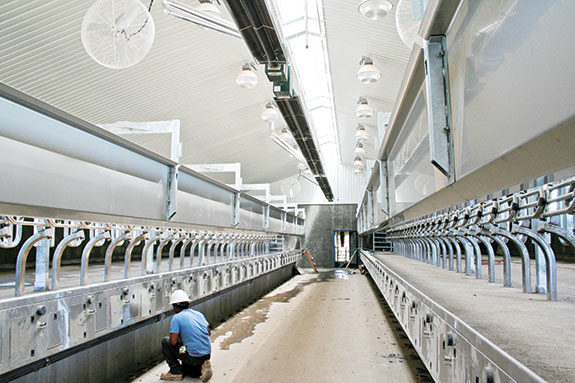There are many things to consider when building a new parlor. A dairyman needs to look at the size of the milking parlor he wants to build, how many cows he will milk and the amount of time he is willing to spend milking.
But most importantly, a dairyman needs to know what type of milkability and milk quality he wants to get out of his parlor.
Then he needs to look at his budget to determine what he can afford.
For example, if he wants to save some money, he may look at putting in a swing milking parlor. It’s a great way to cut costs at start-up and can make a great transition parlor. However, there are a few drawbacks.
This type of parlor will require a high-line milking system. The dairy will need to run a higher vacuum level in order to achieve the average claw vacuum needed during high milk flow. There’s a risk that goes along with that approach. I
f units are not taken off properly to leave the correct amount of residual milk, the teat ends will be exposed to a high vacuum level that may damage them. With a high-line system, a milking unit will see flooding and slugging of the milk because the milk has to get pulled uphill.
If a dairyman chooses this route, it is very important to get a claw that eliminates flooding. Choose a claw designed to deliver the most consistent milk flow possible.
A higher-budget item is a low-line milking parlor that has a basement. This type of parlor is a great way to keep milking equipment clean and dry. It makes servicing the milking equipment very easy.
This type of milking system will allow a dairy farmer to keep a very low system vacuum and therefore minimize the amount of high vacuum teat ends will be exposed to during milking.
However, in this system the pulsation tubes can be very long, which will take longer to evacuate the air from the lines and lengthen the A and C transition phases.
When the phases of pulsation get lengthened, it is harder to get the proper pulsation setting to dial in the performance of the parlor.
Thus, the dairy may have slightly lower flow rates than what is desired. With this type of milking parlor, it is very important the dairy farmer chooses a high-flow pulsator. That will make the air evacuation quicker, virtually eliminating the effects of the lengthened pulsation tubes.
Pulsation rates
When building a new parlor, pulsation needs to be considered. Too often, a dairy farmer is content with a dealer setting a new milking system to the “old standard way.”
The dairy farmer needs to have the dealer put on a pulsation testing device and dial in the system. Since every milking system varies in the length of hose, type of liner and shell and type of pulsators, there is no proper “cookie-cutter” way of setting up a milking system.
To achieve the ideal milkability, a parlor should have its pulsation tweaked so the B phase is between 450-500 ms and the D phase is between 200-250 ms.
Vacuum settings
It is extremely important to select a good claw and liner combination that will dictate the vacuum level. First, choose a claw that will achieve a steady and consistent average claw vacuum, especially in high milk flow.
The claw should also have a capacity for high-producing cows. Then choose a liner that will enable the parlor to meet its goals. I would suggest that a dairy farmer choose a liner type that offers a series of liners within one family.
This will allow a producer to improve their parlor’s performance without changing liner types. A liner series will also allow the dairy to move up in performance as it gets better at managing the parlor and prep procedures.
The vacuum will need to be adjusted as the dairy starts to milk cows in the new parlor and as milk increases and flow rates go up. Check the vacuum settings to make sure the average claw vacuum is still in the range for the liner.
It is highly recommended that a qualified milk quality expert from your dealership regularly check the vacuum setting.
Other settings
A dairyman also needs to consider takeoff settings. The dairy producer should choose a detacher that will allow him to make a wide range of adjustments at the front end and back end of milking.
The setting will need to be checked regularly after the parlor has started working. As the management and the milk quality in the parlor improves, takeoff settings will need to be raised in order to achieve the proper amount of residual milk left in the cow’s udder.
It is also critical that the dairy has good prep procedures as they start to operate their milking parlor. Good prep procedures are the best way to get optimal performance out of the milking parlor, get the best teat health and the highest quality of milk.
We recommend cows have 10 to 12 seconds of teat contact time (stripping, washing and drying). Then attach the unit within 75 to 90 seconds after teat contact. After attachment, adjust the milking unit to hang squarely on the cow as soon as the last teat cup is attached.
What happens if the settings are not correct?
If settings are not done correctly, the dairy will not achieve its goals. With improper settings, milk quality and performance decreases.
If the takeoff settings are not properly adjusted, overmilking can occur. If the vacuum is set too high or too low, the liners will not work properly.
If claws are chosen that are low-capacity and flood easily, the cow will be exposed to very fluctuating vacuum levels. All of these will result in poorer teat health, poorer milk quality, less-than-desired performance, lower milk yields and higher rates of mastitis.
What is the most important thing to remember when building a new parlor?
There is no “cookie-cutter” way of setting up a parlor. Every parlor, every herd and every dairy’s goals are different. Every setting in the milking parlor should be adjusted and customized to each situation.
It is also very important to have a good working relationship between the dairy producer, the dealership and the milk quality expert. The milking parlor will evolve and settings will need to be checked and changed on a regular basis. PD
Photo by PD staff.

Jason LeGassick
Global Brand Manager of Liners
BouMatic







